Extrait de la monographie de John Huddilston - Greek tragedy in the light of vase paintings - London, Macmillan and Co (1898)
Chapter III - AISCHYLOS AND THE VASE PAINTINGS
1. INTRODUCTION
Notwithstanding the fact that the oldest of the tragedians was the least read in the fourth century he easily rivals Sophokles in his influence on art. This was not due to his being more admired, and can only be accounted for by the bold situations that he invented situations new and striking. There are certain of his plays that left a lasting impression on Greek and Roman art. Such are the Choephoroi, the Eumenides, and the Lykurgeia. Further than these, Aischylean plays did not appeal to the artist to any great extent. It is the peculiarly popular inventions distinguishable in these tragedies, their uniqueness, so to speak, that set them apart by themselves, a mark for the artist. The character of the plays is easily denoted. They ring with cries of murder and resound with the storming fury of avenging deities ; we are struck by the perils of the situations and remain all but breathless to learn the issue. These features attracted the painter and sculptor, and this is what meets one on all the monuments that may be called Aischylean. The deep religious vein that pulsates in every line of the mighty tragedian is reflected to some degree on the vases and the sarcophagi. This force in art was rather epic ; it was, in a way, Polygnotean, and the ethical nature of it all but condemned it for the artists who sought the pathos of Euripides. This very fact explains why Aischylos and Sophokles did not address themselves more to the succeeding generations of artists. The ethical was more difficult to express than was the pathetic, and it was not so attractive. The spirit of the times, moreover, demanded the latter as it demanded Euripides, and consequently one should not expect to meet a large number of vase paintings that were made under the influence of either Aischylos or Sophokles. Those that can be associated with the extant tragedies of the former are given in the following pages. It will be observed that certain scenes from Aischylos were greatly in favour in Lower Italy. All of the nine paintings published are from Italian ware. Not one Attic vase that shows an Aischylean scene has, so far as I know, been discovered. In the West, however, where he was quite as much at home as in his own Athens and where he was destined to end his days, the vase decorators were largely influenced by him.
2. CHOEPHOROI
There is no proof at hand that epic literature knew aught of Elektra or the part which she played in avenging her father's murder. The fragments from the lyric poet Stesichoros furnish the oldest literary source for the Oresteia which became later so popular under the hands of the fifth-century tragedians. The trilogy of Aischylos which has happily come down to us is, therefore, the oldest extant authority. When one turns to works of art one discovers a series of vase paintings representing the death of Aigisthos ; yet these are but a little older than Aischylos' work. Events concerned with Orestes' return are even less common in carly art. The Melan terra cotta plaque in the Louvre, which represents a scene somewhat similar to the opening of the Choephoroi, is the oldest of the Oresteia monuments, but still must be dated within the fifth century B.C. It may be considered as fairly well established that Elektra and Orestes first appeared in art but a few years before the production of Aischylos' trilogy in 458 B.C. Nor is it possible, so far as I know, to discover any influence of the Agamemnon or Choephoroi upon artistic productions in the last half of the century. A small group of vase paintings from Lower Italy belonging to the fourth century B.C. do, however, present
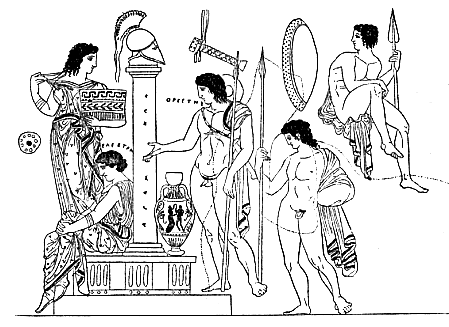
Figure 1 - Naples |
The painting shown in fig. 1 represents a tomb, the base
of which is decorated with triglyphs. Surmounting this is a
stele, crowned with a Corinthian helm, and bearing the name
AGAME[M]NWN. Sitting with her back to the stele on
the left is Elektra, ELEKTR[A], wearing a chiton and
mantle and clasping her left knee in a meditative mood ;
beside her is another female figure similarly dressed and
holding a toilet box in the left arm, an unusually common
article on the vases of Lower Italy. Perhaps the box is meant
to recall the offerings which were brought in it to the
grave. This person is not necessarily Chrysothemis, although
her dress would be more appropriate for Elektra's sister than
for her attendant. It is, however, the work of the latter to
carry such a box of offerings for Elektra. The figure may
therefore be left unnamed. Her face is turned towards
Orestes, ORESTHS, who stands on the right and
appears to be speaking to Elektra, who pays no attention to
his words or his gesture. He is in travelling costume,
chlamys, petasos, and carries a spear and sword, but
curiously enough wears no boots. Below him to the right in a
similar attitude stands Pylades. He has simply a chlamys and
a spear. Another youth sits above on a terrain. He serves to
round out the picture, and indicates at the same time the
attendants of Orestes. In the background are a sword and
shield ; on the grave is an amphora, as an offering, exactly
the shape of the vase on which the painting occurs. There are
numerous restorations in the work, but the main part seems to
be antique. Heydemann states that the inscription on the
stele is genuine, and also ELEKTR[A]. Doubt is
expressed concerning ORESTHS.
We have before us the grave of Agamemnon, at which the first
585 verses of the Choephoroi were played. There is no
trace of palace or royal building. Orestes, accompanied by
Pylades, enters the orchestra and lays his tribute upon his
father's tomb, tumbou d ep ocqw (v. 4), but suddenly
withdraws to avoid the company of women which approaches with
ceremonial step. The chorus and Elektra proceed to perform
their services when the latter discovers the lock of hair,
agalma tumbou (v. 200), and the footprints - two
proofs that Orestes must be near. While she is still
examining the tracks the latter comes up and proves beyond a
doubt, by pointing to the garment that Elektra had once
woven, who he is (vs. 212-232). Perhaps one may think of
Elektra as sitting upon the grave at some point between v. 84
and v. 212, but when she had discovered the traces of
Orestes' presence, she must have been actively scanning the
surroundings. It pleased the artist, however, to represent
her as ignoring the appeal of her brother, or at least
manifesting no signs of recognizing him. But for the presence
of the tumbos one would be inclined to see the
influence of Sophokles' Elektra, where Orestes' words
gain credence very slowly, and where Elektra hesitates long,
before believing his assertions that he is living and
standing before her (v. 1219 ff.). But the Sophoklean tragedy
is played before the palace. The pedagogue and Orestes leave
the orchestra to pour their libations on the grave (v. 82
ff.) when Elektra comes out of the house. The fact that the
recognition scene is represented as taking place at the grave
gives us therefore ample reason for accepting our painting as
under the influence of the Choephoroi. This painting
is strikingly free in its conception ; no words of the poet
can be cited as fitting the situation. The suggestion, the
setting, are Aischylean ; all else is the artist's. The work
is far removed from the character of an illustration.

Figure 2 - Naples |
The second painting is on a Lucanian hydria. The central
scene is again the tumboV of Agamemnon, built up
with several steps and surmounted by a stele with Ionic
capital and bound by a fillet. Elektra sits upon the upper
stop in veil and chiton. She holds the former with her right
hand and looks away into space. On other steps below her are
a lekythos and other small vases, also a pomegranate and a
fillet. The offerings are much more abundant here than in
fig. 1. Unnoticed by his sister, Orestes approaches the stele
on the left, dressed as in fig. 1, with the addition of
boots. He is about to pour a libation from a kylix in his
left hand. The male figure sitting next to him is doubtless
Pylades. He turns his head towards the main scene. The
remaining figure here is but remotely associated with the
action. The persons on the right are more interesting. The
youth standing on the step of the grave about to lay a wreath
upon the stele is denoted by his kerykeion as Hermes. He
wears a travelling costume without the usual boots. An
elderly, bearded, male figure stands behind him. He is not
characterized except by a mantle and a long staff, but has
been interpreted as Orestes' pedagogue. The only objection to
this is his dress, but this may be due to the carelessness of
the artist. Behind him is another bearded male figure sitting
upon a sort of bag, or pack. His short chiton, shoes, and
staff all point him out as a traveller. The peculiar,
close-fitting cap denotes him as a foreigner. The female
figure on the extreme right in Doric peplos carries an
aryballos in her loft hand, and gazes at the group before
her. Perhaps she belongs to Elektra.
The discussion of fig. 1 above applies equally well to
Orestes and Elektra here. We have practically a repetition of
the group. The former figure is, however, thought of at an
earlier moment. By removing Elektra, one may think of Orestes
at the opening of the play. He holds the vase in his hand
rather than the lock of hair. The first words of the prologue
are suggestive :
 |
Chthonian Hermes, who guards the ancestral rights, has really manifested hirnself in the painting, and has appeared as a particular ally. The act of crowning the stele declares Hermes' friendliness toward the family and his interest in Agamemnon's shade. Elektra addresses him also and beseeches him to hear her supplications and pity her and her dear Orestes (v. 124 ff.). We may note, therefore, a special fitness in the artist's expressing this double relation of Hermes to the children. Invoked by both of them as a protecting god he introduces nothing that is not in harmony with the spirit of Aischylos. The addition of this figure is, moreover, a good instance of the liberty which the vase painters took with their authors, and shows well the difference between illustration and independent work. It cannot be denied that with the assistance of this monument one is led to see between the lines of the Choephoroi. The pedagogue who does not appear in Aischylos is nevertheless a natural extension of the group. It will be remembered that he speaks the prologue in the Elektra of Sophokles and occupies the place which Pylades usually fills. In Euripides' Elektra (v. i6), Autourgos says that Orestes had been given into the charge of a trofeuV. The person resting on the pack appears at first sight a gratuitous addition of the artist, but on closer examination the suggestion for him is found in the poet. When Orestes explains to the chorus that he and Pylades will attempt to gain an entrance to the palace, he states that they will disguise themselves as foreigners by speaking the Phokean dialect (v. 563 f.). To Klytaimestra's interrogations (v. 668 ff.) he replies :
 |
In other words, he is a stranger from Phokis who has to carry his own pack. It is upon this sagh that the figure is resting. The artist has characterized him as a foreigner by the peculiar cap. No Greek ever wore such a head-dress. The make-up hints at the appearance of Orestes seeking admittance to the palace, while, of course, the person is to be understood merely as one of the latter's servants. Whatever he may have said about carrying his own pack, no artist would have thus represented him. On the oldest of the Orestes-Elektra monuments. the Melan relief, there is such a figure standing behind Orestes with his luggage strapped to his shoulders. It seems to me that the painter has naïvely caught up the spirit of the text and brought in a figure which goes far towards adding a charm and interest to the scene.

Figure 3 - Munich |
Another Lucanian hydria representing the same scene is
published here for the first time, in fig. 3. It will be more
instructive to point out the few points in which the two
paintings differ from each other than to describe this one
entire. The column in 3 has a Doric capital with maeander and
checker-board ornament : in 2 the capital is Ionic. In 3
Hermes stands on the ground ; in 2 he stands on the step to
the grave. Elektra reaches out her left band in 3 as though
to receive the libation ; in 2 she is unmindful of Orestes.
The latter holds a kylix in 2, and in 3 a pitcher. His hat is
a pilos in 3, and he wears it ; in 2 the petasos bangs on the
back of his neck. The Phokean attendant sitting upon the
luggage is in 3 upon the left, and in 2 upon the right. There
is an extraordinary likeness between the two. There is the
same crooked nose, short chiton, and odd cap, but the latter
has no tassel in 3. The servant wears, besides, a chlamys and
rests his stick over his leg. Behind him is the nude youth,
as in 2, upon the left, holding an ointment vase in a sort of
carrier. The two male figures of 2 adjoining the main scene
are wanting in 3. In their stead is a female figure sitting
upon a stool and holding a large toilet box. She is dressed
in a Doric peplos with an apoptygma. She is evidently
an attendant of Elektra, and reminds one strongly of the
figure in fig. 1. Behind her is the charming girl, exactly as
in 2, except that she carries the aryballos in her right and
in the left hand a small box.
The painting is, it would seem, more beautiful than that of
fig. 2. although the publication of the latter is an old one,
and may be more or less inaccurate. I have not seen the vase
myself. The scene is abbreviated by one figure ; Pylades
would be expected.
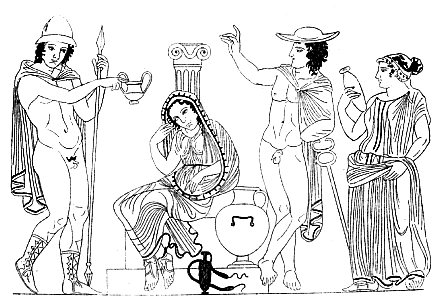
Figure 4 |
Still another painting is given in fig. 4, showing a
further step of simplification. Only the middle group, with
the female attendant carrying the aryballos, occurs. Hermes'
position is the same as in fig. 2, but the artist has
forgotten to draw the wreath in his right. His chlamys, too,
is buttoned properly instead of being wrapped around his arm.
The latter, however, has the same stumpy appearance seen in 2
and 3. As the scene is simpler, so the offerings on the tomb
are fewer. Orestes' libation is here in a kantharos. The
painting is a careless piece of work, and cannot be ranked
with the other two. It is, however, very interesting as
giving another link to the chain of evidence.
There can be little doubt that these vases all belong to the
same artist or that they come from the same locality. The
marvellous agreement that runs through them is something
quite extraordinary. I know of no other similar cases in vase
paintings of the red figured ware. The popularity of this
scene, and therefore of Aischylos' Choephoroi, is
attested by such a series of paintings as one cannot find in
the case of any other work in Greek literature.
Since writing the above I have discovered in the Louvre
another Lucanian vase that represents a further
simplification of this scene. The painting is practically
identical with the middle group in fig. 3.

© [Louvre.edu] - Photo H. Lewandowski |
Peculiar to the Louvre painting are the tomb with five steps and the rather tall column, Doric order, surmounted by a krater ; an aryballos and strigil, in addition to the taenia, are fastened to the column. There is a further slight variation in Elektra's position, for on her right is a krater. On her left is a lekythos ; below are the two pomegranates, taenia, and black lekythos, just as in fig. 3. The only difference in the other persons is that Orestes holds out a kylix and not a pitcher.
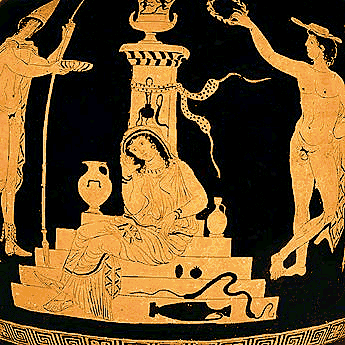
© [Louvre.edu] - Photo H. Lewandowski |
The painting is evidently a product of the same studio as are those in figs. 3 and 4. It forms another member of this remarkable class of pictures that stands alone, unique in Greek ceramics, and bears witness to the enormous popularity of this scene from Aischylos. In the face of this important chain of evidence one is safe, it seems to me, in claiming that Aischylos was acted in the fourth century B.C. and that considerably. What kept this scene before the public and induced the artist and his pupils to turn out so many copies of the sanie work ? To have been thus so saleable the picture must have been popular, and this could have come about best through the acted drama. These vases and those following, based on the Eumenides, must impress the impartial student with the fact that Euripides and Sophokles did not by any means oust Aischylos compietely in Lower Italy.
3. EUMENIDES
The various stories which may have been popularly told in regard to Orestes' purification, and his reconciliation with the Furies, prior to March 458 B.C. were swept for ever into oblivion by the last member of Aischylos' trilogy. The stamp of his genius has ever remained upon the myth, and no one ever attempted to repeat his work. All the elements of the persecution were cast by him into their final mould. The immense influence of this work is attested in no way more forcibly than by the monuments of art to which one can point. There is a long line of vase paintings, dating from the fifth century, that bear witness to the wide popularity of the Eumenides, and that give the most direct and authoritative testimony of the influence of the play upon the masses of the people. A sharp distinction must be made, however, between paintings that illustrate the general myth and those that exhibit unmistakable Aischylean features. Orestes' pursuit and expiation were universally known, and the tale was so popular that it often found its way into art where the artist had in mind no poetic version of the story. So it is that there is a number of paintings representing Orestes either pursued by the Furies or already having reached the omphalos, which do not represent any situation or combination of situations that can be traced to Aischylos. Of the number whose subject is Orestes at Delphi, at least four, it seems to me, are to be explained as substantially under the influence of the Eumenides and representing the first scene of the tragedy in more or less modified form.
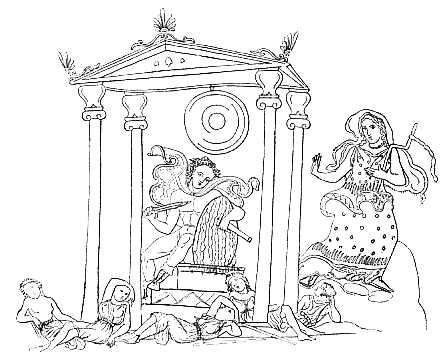
Figure 5 - St. Petersburg |
I discuss first the scene on the St. Petersburg krater,
fig. 5. The painting belongs to the latest period of ceramic
art, and is in nearly every detail a hasty and careless piece
of work. In an Ionic temple on four columns, all painted
white, Orestes, flesh dark red, sits en face with his
left arm around the omphalos which is covered with a white
net. He holds the sword in the right and the sheath in the
left, and wears boots and chlamys. On the steps of the temple
lie five sleeping Furies. They are painted, flesh black, only
in rough outline. Their dress is a short chiton. On the
right, hastening from the temple, is the Pythia in long
chiton and veil. She carries the big key - emblem of her
office as klhdoucoV. Her flesh is white.
The addition of the temple strikes one at once as being in
harmony with the poet. To be sure, this need not mean a
particularly close relation with the actual production of the
play in a Greek theatre. Our temple is merely one of the
numerous buildings of this class found upon the vases of
Lower Italy, some of which were intended evidently as
suggestions of the stage setting. In the present instance the
coincidence is a happy one. The Agamemnon and the
Choephoroi, which had just been produced, were both
played before the palace at Argos, and this scenery was
changed to represent the Apollo temple at Delphi for the
third play. There can be no question as to this
skhnh for the Oresteia, at least, even though
one does not allow an extensive background for the earlier
plays. The painting is well adapted, therefore, for placing
the opening scene vividly before us. It brings one closer to
the meaning of the text than is apparent at first sight. In
v. 1048 ff. of the Choephoroi Orestes saw the Furies.
They wore bright chitons, and had snakes in their hair. He
calls them hounds from whose eyes oozed ugly drops of blood.
The chorus evidently did not see them, for Orestes cries :
«You do not behold them here, but I do». At these
words he is away to Delphi to seek Apollo's protection.
During the intermission which followed between the two plays
the necessary alterations were made in the skhnh and
the costumes were changed. The chorus in particular, which
had represented Argive maidens, underwent considerable
transformation in order to appear again as Furies. The
Eumenides is opened by the Pythia, who comes from the
temple. She recounts the nature of her duties, and mentions
various gods in her address until v. 30, at which point she
turns from the orchestra to re-enter the temple and attend to
the delivery of responses. In a moment she reappears in great
fright, and begins to relate the cause of her alarm. The
sight described is exactly that which the painter had in
mind. One is able, however, to get behind the scenes with the
aid of the picture, for the front of the temple is removed so
that the interior is plainly in view. To compare the words of
Aischylos and the painting more closely - the Pythia says
that a terrible sight drove her ek domwn twn Loxiou.
The artist has expressed this with some action, for she is
actually represented as leaving the house of Loxias.
She adds further :
 |
The picture shows the man upon the omphalos, and in his
band the drawn sword. One may imagine that the suppliant's
hands are stained with blood, when but a short time before he
had fled from the s
 |
Surely a marvellous troop of women fits the group
which we see before us. In this particular the work is
practically an illustration of the text. The distinction is
at once made that the figures are not women nor Gorgons nor
Harpies. They are apteroi and melainai, and
shore with unapproachable blasts. It should be noted that the
figures in the painting are also black, as though in direct
agreement with Aischylos. They are further wingless, while
the unpleasant details added are conceivable from the
appearance of the ugly creatures. The number five is of
course a mere accident. They lie here in an unconscious
stupour tilt the ghost of Klytaimestra arouses them again.
The Eumenides is, as is well known, the only extant
Greek tragedy in which the chorus is not visible from the
beginning of their part. In the Persai and
Supplices of Aischylos and the Bakchai and
Supplices of Euripides the chorus is, however, in the
orchestra when the play opens.
There are still two other vase paintings to be considered in
this connexion. They present minor variations from the one
just discussed, but on the whole the three betray a common
source.
Figure 6 - Ruvo krater
|
In fig. 6 one sees also the interior of the temple represented by three Ionic columns. Various dedicatory articles hang from the wall and ceiling. Further indications of the sanctuary are the two tripods, the laurel tree, and the omphalos. Orestes, characterized as usual by the drawn sword and flying chlamys, has fled to the latter and embraces it. His erect hair shows his fright. Apollo with bow and arrows hastens behind him and gestures with his right hand to drive back a Fury who is swooping down upon Orestes. She is but half in sight, and wears a short Doric peplos, and her flesh is black. The Pythia, with dishevelled gray hair and frightened mien, quits the sanctuary on the left. Her key, indistinctly drawn in Jahn's publication, owing probably to the copyist's ignorance of what the article really was, has just fallen from her hands. Artemis in her huntress costume, carrying two spears, stands on tiptoe on the right of the omphalos and shades her eyes with her right hand as she peers at the disturbance. Two dogs are with her.
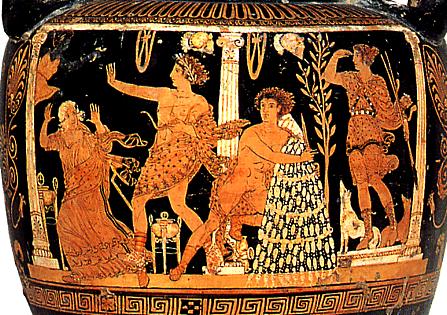 |
The time of the Pythia's exit from the temple, as in fig. 5, and the rater moment when Apollo orders the Erinyes from the sanctuary, are well combined in this painting :
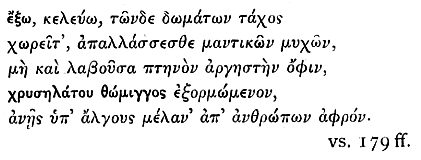 |
Apollo's authoritative bearing and absolute power in his own precinct are very well brought out by the artist. One can all but hear the exw, keleuw of Aischylos, and the arrows that the god holds in his left hand seem to show that Apollo is quite ready to carry out his threat. The whole is, moreover, dramatically told, and in this respect the stage influence is easily traceable in the painting. That the Fury is black accords again with the poet's melainai (v. 52). The presence of Artemis lends a certain charm that one can attribute to the artist's desire to appear original.

Figure 7 - Berlin |
The following work falls still further away from the
scenery of the play. Fig. 7 shows a painting on the neck of a
large Apulian amphora in Berlin. The limited space, and the
secondary position likewise, have perhaps curtailed the scope
of the work. No architectural details are given. The
sanctuary is denoted by the omphalos and the tripod. Orestes
has sought protection at the former, as in the preceding
scenes, and looks back at a Fury, with short dress and huge
wings, who runs toward him with a dagger in her right and a
burning torch in the left hand. Apollo, who sits upon the
tripod, a Laurel bough in his hand and wreath in his hair,
extends his right hand to repel the Fury as in fig. 6. On the
right the Pythia, dressed as in fig. 5, leaves the shrine in
fright, gesturing at the unexpected visitons. The painter has
forgotten to give her the key. Beside her is an attendant
carrying a sort of kylix in the left hand and looking back at
the sanctuary.
It does not appear necessary to take up the details here
after the examination which has been given to the preceding
paintings. The artist's debt to Aischylos was quite as direct
as in the case of the two other works. The greatest
modification occurs in the figure of the Fury, which is a
being far removed from the Aischylean type.
A painting on a bell-shaped krater in the Louvre is less
hampered by the scene given in Aischylos, and is accordingly
more artistic. The inventiveness and individuality of the
artist come prominently to view, and the result is an
intensely interesting composition. The combination of events
and the manner in which all is told bring one a great deal
nearer to the deeper meaning of Eumenides than any other
monument with which I am acquainted.
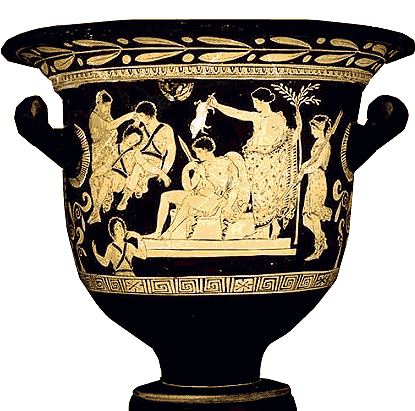
Figure 8 - © Musée du Louvre |
The shrine of Apollo, the mucoV of vs. 39 and 170, is denoted by a platform on two steps, above which are the laurel tree and the omphalos. The god stands to the left in large, embroidered chiton or chlamys, grasping the free with his left hand and extending his right, in which is a young pig, over the head of Orestes, who sits with his back to the omphalos. The latter holds his sword in his right hand, which is raised meditatively to his chin. Artemis stands behind the platform on the right, characterized by her costume and the spears. In the left-hand upper corner the shade of Klytaimestra, veiled, is engaged in arousing two Furies who sit fast asleep. She points toward Apollo with her right hand. Below is the half-figure of another Fury apparently rising out of the ground wide-awake. The Erinyes are all dressed like Artemis, in short costume and high boots.

© [Louvre.edu] - Photo Erich Lessing |
The artist has combined with the first scene a moment earlier than the action of the play. Orestes' expiation preceded the prologue of the Pythia. The purificatory rite had been performed immediately on his arrival at Delphi, for, when he first appears in the Eumenides, he is undefiled. This is plainly declared to Athena in vs. 237 ff., and to the Chorus and Athena in vs. 280 ff. While the purification is represented in various ways upon the other vase paintings, this ceremony is the only one that reminds us of Aischylos. The latter hints at the manner of the rite, and this passage has unquestionably suggested the group which we have before us :
 |
While the blood was fresh it was cleansed at the shrine of the god Phoibos by purification with the blood of pigs. The ceremony is referred to again in
There is, therefore, in the painting a representation of
this service with pig's blood. The freshness and beauty of
the scene are peculiar to works of art in the Pheidian age,
and the painting must be considered as a valuable witness of
Aischylos' influence. The fact that the work is Apulian and
not Attic supplies an interesting bit of evidence for the
extension of Athenian literature in Lower Italy during the
fifth century B.C. Tarentum, which was scarcely less Athenian
than Athens, received an edition of the plays brought out at
the Greater Dionysia soon after their appearance in Athens.
It is further to be remembered that Aischylos' long connexion
with Syracuse had probably made him more widely known in the
West than was either Sophokles or Euripides during the fifth
century. Our vase belongs to the last decades of the century,
perhaps as early as 420 B.C., and in this period Euripides
had scarcely gained a large following in Magna Graecia.
Apollo's speech follows directly upon that of the Pythia's.
How the god appeared in the orchestra is a question on which
scholars are not agreed. The most widely accepted view is
that the ekkyklema was brought into use, and that on it the
whole company was in some manner rolled or pushed out from
the temple to the orchestra. This means that the chorus of
twelve or fifteen, together with Orestes, Apollo, and Hermes,
was moved bodily forward from the skhnh, far enough
at least to give the audience a glimpse of what had been the
interior of the temple with ail its surroundings. Apollo
seems to speak of the Furies and Orestes as though he himself
saw them and as though the audience could see them 1. They
are in fact in plain view if one insists upon the literal
meaning of his words. It is argued on the other hand that
such a ponderous weight could not have been moved by any
machinery at Aischylos' command. In other words, the
ekkyklema, in the interpretation usually given the term, is
not to be counted a part of the Aischylean scenic apparatus.
If Apollo stood in the doorway of the temple where he could
look in upon the Furies and Orestes, and at the same time be
seen by the audience, one has really no need of any
machinery. The shade of Klytaimestra must also be thought of
as appearing in the same place. She glances in upon the
Furies who continue to give forth their grunts till v. 140,
when they for the first time appear in the orchestra. There
is much in favour of this explanation of the arrangements for
the scene. Fortunately for our purpose it makes little
difference which of the two opinions one follows. Conclusive
evidence is hardly to be reached either one way or the other,
yet the notion that Aischylos did not employ such extensive
machinery as the ekkyklema must have been certainly does not
harmonize either with the extant plays or with the tradition
in regard to Aischylos' inventions. My conviction is that
from v. 64 the interior of the temple was in some way
visible, and that the whole audience could see Orestes at the
omphalos, surrounded by the slumbering Furies. The god
reassures the suppliant of his support, and bids him leave
for Athens and embrace the sacred image of Athena. He turns
to Hermes, who is at hand for the occasion, and bids him
accompany Orestes. At this point, v. 93, the two quit the
orchestra, Orestes passing over the bodies of the
Furies.
Our painting follows the development in vs. 94-140, where the
shade of Klytaimestra appears and chides the Erinyes for
neglecting their duty and forgetting her and her rights. The
artist has grasped the spirit of the poet, and has given a
graphic account of the scene such as one is not likely to
forget. The dread figure of the veiled ghost, who glances
searchingly at the sleeping instruments of her vengeance and
endeavours to rouse them into consciousness, is a creation
but little inferior to that in Aischylos. Her position on the
extreme limits of the sanctuary serves to express the
uncleanliness of the spirit and the incongruity of its
appearing within the sacred ground. The gesture towards the
main group connects the two scenes and lends a unity to the
whole. This is real art and no illustration. One must
remember that Orestes is at this time on his way to Athens,
and that the shade did not appear in his presence. The very
fact that the painter chose to unite the two moments adds
greatly to the general effect. The tragedy is played in part
before us. The number of Furies representing the chorus is
the same that one meets first in Euripides, and that is
particularly emphasized also by Aischylos in
Their dress is that of the later type of Erinyes - the
huntress-costume of Artemis. This facilitated their motion.
Perhaps the half-figure of the awakened Fury may be rising
from the earth to continue the pursuit, but it seems to me
more probable that the half-figure is such from choice. After
the appearance of the Erinyes in the Choephoroi they
are certainly above ground tilt conducted to their new home
under the Areopagos.
White the story of Agamemnon's murder and the succeeding
terrible revenge wrought by Orestes, as well as the latter's
atonement at Delphi, were all a part of the legendary
inheritance from a very early period and had played for some
centuries, at least, before Aischylos an important
rôle in the epic and lyric literature, it
remained for the great tragedian to break new ground for the
last chapter of the Oresteia. Orestes' acquittal and
deliverance were, prior to Aischylos, distinctly Delphic in
setting ; in his hands all became decidedly Athenian. Apollo
had once been the sole divinity to absolve the murderer ;
Athena became the new arbiter and director of the case. The
temple at Delphi gave way to the Old Temple of Athena
upon the Acropolis. Keeping these facts in mind, one has to
look about for vase paintings which show traces of this Attic
turn. So far, only the early scene at Delphi has claimed our
attention, and here it has been possible to point out several
compositions that demand the Eumenides to the
exclusion of popular tradition.
From v. 235 the scene is transferred from Delphi to Athens,
and remains throughout the rest of the play the Old
Temple on the Acropolis. Athena becomes the centre.
Everything moves about her. The one impressive figure in this
part of the tragedy is the goddess. Orestes is simply a poor
helpless mortal - the apparent subject of the action. He and
the Erinyes sink into insignificance when compared with the
majestic figure of Athena. Substantial traces of the
influence of Aischylos' invention have reached us on the
vases. A small number of paintings claim the right to be
considered under this head. The composition of all (I know
three such) is so similar that it seemed necessary to
reproduce only one.

Figure 9
Photographie couleur sur Theoi Project |
The painting shown in fig. 9 represents the sanctuary at
Delphi with the tripod and the omphalos ; kneeling upon the
latter is Orestes, in the same costume as that noticed in the
preceding monuments, holding two spears in addition to the
neospadeV xifoV. He glances up to the right, where
Athena looks down upon him. Her right foot rests on a sort of
plinth ; she carries a doublepointed spear in her left hand
and wears a Corinthian helm with peculiar crest. Her dress is
an embroidered Ionic chiton and large aigis. The latter is
not uncommon on the fourth-century vases, and is
characteristic of the exaggeration of types in this period.
Apollo stands on the left of the omphalos, with a laurel
branch on which are hung fillets and pinakia. He
looks to the left at a winged Fury with a very elaborate
costume, a huge serpent about her body and one in her hair ;
above the tripod is the bust of another Fury on whom are four
snakes. In the left-hand upper corner a bust of a youth with
chlamys, pilos, and a spear is most likely meant for Pylades.
Corresponding to this on the other side are the head and
shoulders of a woman, interpreted as Klytaimestra.
The two other vase paintings are, in the main, close
counterparts of this and need not be described here. The
Vatican amphora is particularly interesting as representing
Athena with aigis extended over Orestes to protect him from
the Furies. The Capua hydria in Berlin takes precedence over
the other two in age, and furnishes us with the nearest
approach to Aischylos' time. It falls within the fifth
century, while the others are to be placed in the last half
of the fourth century. The introduction of Athena is the
unmistakable sign. She intervenes at Delphi simply because
Aischylos introduced her in Athens. The artist transferred
her to Delphi and combined the two scenes of the tragedy. If
one considers only Orestes and Athena in fig. 9, and reads
the interview between them in the Eumenides, he will
appreciate at once how well the painter has managed his task.
The whole make-up of the figures is that of stage characters.
This is especially noticeable in the dresses of the Fury and
Athena. This elegance and finery on vases of the fourth
century were widely regulated by dramatic performances.
The set of paintings which thus associates Athena with
Orestes' delivery may be counted as the direct product of the
Eumenides, and therefore important witnesses for the
influence of Aischylos upon the succceding century of Greek
art.